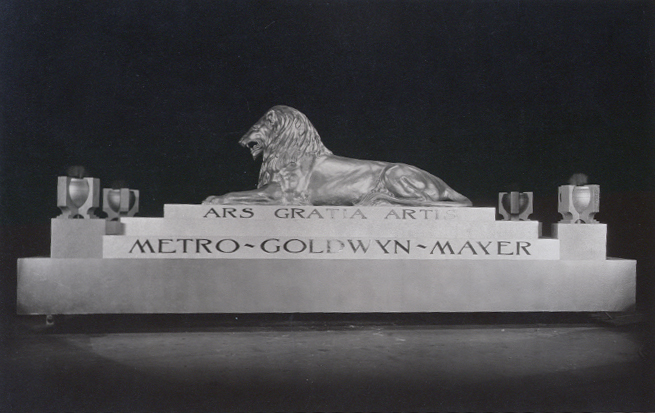
- TitleMetro-Goldwyn-Mayer Art Department records, 1923 - 1961 (inclusive)
- Collector
- Date(s)1923 - 1961 (inclusive)
1937 - 1957 (bulk) - Related names
- Description
3.5 linear ft. of papers
1 item(s) of artworks1. Subject files
- Summary
The collection, which consists of files maintained by either Cedric Gibbons or William Horning, contains departmental records, including studio memoranda and correspondence, production records, reports, research, and script breakdowns. Areas covered include art directors, labor relations, legal matters, main title cost breakdowns, miniatures and special-effects weekly reports, memoranda and reports of shots in progress for the Warren Newcombe unit, personnel matters including contract data, production costs, publicity, research, scenic art, screen credits, set construction costs, set decorators, stage construction, Technicolor, three-dimensional films, and wartime activities (World War II).
- Scope notes
Special Collections
The MGM Art Department Records span the years 1923-1961 (bulk 1937-1957) and encompass 3.5 linear feet. The collection appears to consist of the files maintained by either Cedric Gibbons or William Horning. Apart from providing an invaluable resource for the study of the workings and history of the MGM Art Department, the collection provides valuable insight into the workings of a major studio (included, for example, are many of the general memoranda sent to the various studio executives and heads of department). Departments represented include accounting, camera, construction, international (regarding efforts to use international signs rather than English-language signs on film sets), laboratory, location, matte shots, modeling and plastic shop, nursery, process shots (A. A. Gillespie unit), production, property, publicity, and sound. Individuals involved include J. J. Cohn, E. J. Mannix, and studio manager W. W. Spencer. Organizations represented include the Academy of Motion Picture Arts and Sciences; Illustrators Local #790; Illustrators and Matte Artists of the Motion Picture, Television and Amusement Industries, Local #790; Motion Picture Research Council; Screen Office Employees Guild; Set Designers and Model Makers Local #847; Society of Motion Picture Art Directors; and the Society of Motion Picture Interior Decorators.
Areas covered include art directors, labor relations, legal matters, main title cost breakdowns, miniatures and special-effects weekly reports, memoranda and reports of shots in progress for the Warren Newcombe unit, personnel matters including contract data, production costs, publicity, research, scenic art, screen credits, set construction costs, set decorators, stage construction, Technicolor, three-dimensional films, and wartime activities (World War II).
Of particular interest are a 1937 letter correcting the still-held opinion that Slavko Vorkapich was responsible for the earthquake sequence in SAN FRANCISCO; a memorandum detailing the starting dates for the Art Department; a seven-page memorandum from E. J. Mannix on films concerned with war and its problems, dating from 1942; lists of productions from 1924 to 1955, with information as to total production cost, number of sets and total set cost; detailed information as to office procedure within the Art Department as of 1946; and breakdowns of scripts as to scenes, characters, and shooting dates for various films from 1936 through 1940. Esoteric items include a 1951 laboratory report on the dangers of Metaldehyde (used in artificial snow) and an agreement between Rodgers & Hammerstein Pictures, Inc., and Loew's Inc., for the use of MGM facilities for the filming of OKLAHOMA! (1955). - BiographyMetro-Goldwyn-Mayer was formed in 1924 when the theater circuit Loew's Inc., owner of Metro Pictures Corporation, acquired Goldwyn Pictures Corporation and Louis B. Mayer Pictures and subsequently merged the three companies. The Culver City studio soon became one of the strongest and most prestigious of the major production companies, superior both in profits and in critical acclaim throughout most of the 1930s and 1940s. During the 1950s changes brought about by the Paramount consent decree eventually rendered the studio system obsolete, and MGM, which had once dominated that system, suffered a slow decline. The studio was purchased in 1970 by Kirk Kerkorian, who sold off most of its assets and, in 1973, shut down the distribution arm of the company. Ted Turner purchased MGM in 1986, then immediately sold the studio to Lorimar Pictures while retaining the film library and script material (see Turner/MGM scripts). Acquired by a consortium of investors in 2005, Metro-Goldwyn-Mayer, Inc. continues to function as a film production and distribution company out of its Century City, California headquarters.
- Subjects
- Acquisitions InformationGift of Metro-Goldwyn-Mayer, 1985.
- Preferred citationMetro-Goldwyn-Mayer Art Department records, Margaret Herrick Library, Academy of Motion Picture Arts and Sciences.
- DepartmentLibrary
- 12
- AvailabilityFor information on the contents and availability of this collection please contact the Reference and Public Services department at ref@oscars.org.
- Moving Image Items
- Library Holdings
